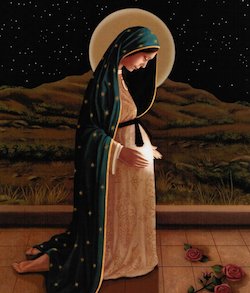 This is certainly not the first thing that comes to our mind when we think of the annunciation, but when Mary accepts the message of Gabriel, her fiat is a yes to God’s plan for her sexuality:
This is certainly not the first thing that comes to our mind when we think of the annunciation, but when Mary accepts the message of Gabriel, her fiat is a yes to God’s plan for her sexuality:
“Mary shows us how to accept the gift of our embodiedness, and this includes the God-given sex of the body. In this it is important to note that Mary’s exemplarity of what it means to accept the gift of one’s body means that the body is not an obstacle to overcome but, rather, a gift to be lived. Mary delights in her body, especially in its God-given sex: femininity. It is precisely in her gift of being a woman that Mary was fashioned and called by God to be the Theotokos [God-bearer]. The gift of her body is exactly what helps her to become the Theotokos. Just think of what would have happened if Mary had rebelled against the gift of her feminine body! We would be in a very different situation today” (Mary and the Theology of the Body, pp. 55-56).
Mary’s fiat marks the exact moment of the Incarnation, the Word Made Flesh. The basic thesis of JP II’s Theology of the Body is that
“The body in fact and only the body is capable of making visible what is invisible: the spiritual and the divine. It has been created to transfer into the visible reality of the world the mystery hidden from eternity in God, and thus to be a sign of it.” (TOB 19:4, Feb 20, 1980)
This became abundantly clear when Christ entered the world to make God visible to the whole human race. In the Incarnation the mystery of God has been revealed in human flesh. For in Christ, “the whole fullness of the deity dwells bodily” (Colossians 2:9). Says the pope:
“The fact that theology also includes the body should not astonish or surprise anyone who is conscious of the mystery and the reality of the Incarnation. Through the fact that the Word of God became flesh the body entered theology…through the main door” (TOB, 23:4 – April 2, 1980)
Vatican II tells us that only in the mystery of the incarnate Word does the mystery of man take on light and that Christ fully reveals man to himself and makes his supreme calling clear (Gaudium et Spes, 22). What God becoming man reveals to us about our bodies is that they are more than just carnal realities. The human body is intimately united to the human spirit and this unity is meant to be a sign in the world of the hidden mystery of God.
There is a modern sort of dualism these days that suggests that human beings are essentially made up of two separate natures. We have a body and a soul and what we do with one doesn’t necessarily have to do with the other – mostly, what we do with our bodies isn’t nearly as important as our souls or who we are inside.
Case in point: a former priest friend of mine was having a conversation one day with a girl who described herself as an “exotic dancer.” When he asked her how she felt about men using her for their own selfish gratification, she said, “oh, they’re not using me, just my body.” In other words, her body and her stripping had nothing to do with who she was as a person.
But man is an incarnate spirit with one human nature. In his Letter to Families, JP II explains that man
“is a person in the unity of his body and his spirit. The body can never be reduced to mere matter: it is a spiritualized body, just as man’s spirit is so closely united to the body that he can be described as an embodied spirit”
Death may separate the body and soul, but this is not the be all and end all of human life. In just under a month, we will be celebrating the resurrection of the Word Made Flesh, whose conception we remember today. Christ’s Resurrection reminds us of the resurrection of our own bodies at the end of time in which our souls will once again dwell for all eternity!
There is a reason they say “actions speak louder than words.” That is because it is precisely our bodies and what we do with them that reveal “who we are on the inside” and much more!